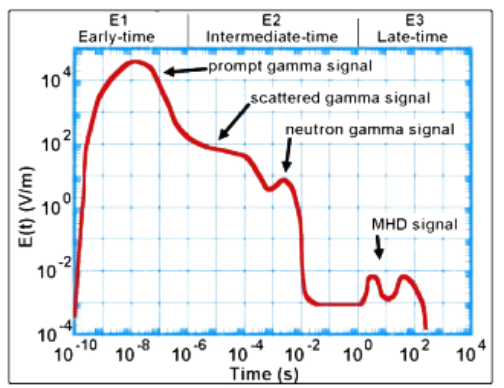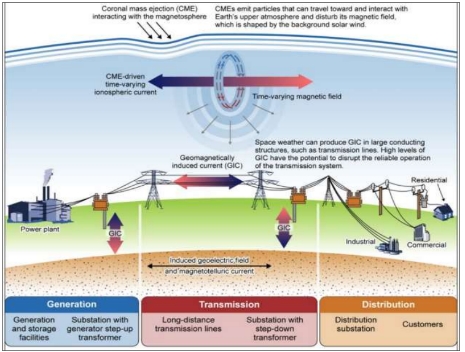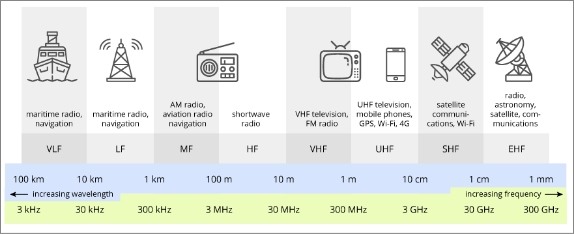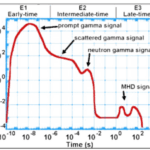
What is HEMP/EMP?
An electromagnetic pulse can be generated by detonating a nuclear weapon in the upper atmosphere. Often referred to as HEMP, the event simultaneously generates multiple waveforms that vary in timing, duration, power and wavelength. The waveforms are be broken into three phases, E1, E2 and E3. The first phase, E1 is characterized by a high amplitude, extremely short duration signal capable of overwhelming and destroying semiconductors embedded in electronics. The leaner, faster, high-capacity micro-circuits within modern devices are especially vulnerable. The E2 phase consists of electromagnetic waves similar in intensity and duration to waves generated by lightning strikes. Although E2 waves can be destructive, our society appears to be protected against E2 due to commonly installed lightning suppression systems. Lastly, E3 signals are characterized as being similar to a GMD, with lower amplitudes and much longer durations than the E1 and E2 elements. E3 waves tend to impact infrastructure connected to long conductors such as power lines, metal pipelines, or even railroads.


What is GMD?
Solar storms are naturally occurring space weather events that produce coronal mass ejections (CME) which can travel through space toward Earth. When charged particles from CMEs hit Earth’s magnetosphere and ionosphere, they create a geomagnetic disturbance (GMD) that affects satellites, power grids, communications, navigation, and more (as shown in Figure 2.1). When CME-induced GMDs impact the power grid, they can overheat high-voltage transformers to the point of irreversible damage. As critical components of power transmission, damaged transformers can lead to widespread power outages. Although space weather events occur often, the severity is generally low and there is little to no impact on our daily lives, particularly in communities with close proximity to the equator. However, researchers estimate that the chances of a large-scale GMD event are as high as 12% every decade.


What is RFI?
Radio frequency interference is emitted by most electronic and electrical devices like switching power relays, industrial controls, medical instrumentation, electronic printers, personal computers, laptops, game consoles, computing devices, etc. There are two ways by which an electronic or electrical device emits radio frequency interference: radiated radio frequency interference and conducted radio frequency interference. In the case of the former, the interference is directly emitted into the environment from the device itself, whereas in the latter, the interference is released into an AC power line through the power cord of a component or device. In the case of satellite communications, radio frequency interference can happen naturally as well as intentionally. Different forms of space weather, including solar storms, can cause a natural radio frequency interference, whereas man-made interference is considered intentional radio frequency interference. Proper shielding in the enclosure of a device helps in controlling radiated radio frequency interference. A power line filter can help in controlling conducted radio frequency interference to satisfactory and acceptable levels. In the case of satellite communications, the use of highly directional antennas and strong end filtering can help in solving narrowband radio frequency interference. In the case of broadband interference, modification of the source can help in bringing down the interference. Safety agencies and many government bodies have established norms concerning radio frequency interference and noise emissions. They also have norms and regulations with regard to radio frequency communications.
What is EMI?
What is an electromagnetic interference?
Electromagnetic interference (EMI) is unwanted noise or interference in an electrical path or circuit caused by an outside source. It is also known as radio frequency interference. EMI can cause electronics to operate poorly, malfunction or stop working completely.
EMI can be caused by natural or human-made sources. Using high quality electronics, electrical shielding, and modern error correction can reduce the impact of EMI.
A common example of EMI is when a cellphone is placed near powered audio equipment or speakers, and it causes a noise or series of beeps to be heard.
What causes electromagnetic interference?
EMI occurs because of the close relationship between electricity and magnetism. All electrical flow produces a small magnetic field. Conversely, a moving magnetic field produces an electrical current. These principals allow electric motors and generators to work. Additionally, all electrical conductors can operate as radio antennas. High powered electrical and radio sources can produce unwanted effects in devices far away. As electronics become smaller, faster, more tightly packed and more sensitive, they become more susceptible to these effects, causing EMI.
The sources of EMI can be broadly split into two categories: naturally occurring and human-made.
There are some sources in the natural world that can produce powerful enough electric fields to affect electronic devices. Lightning can produce strong electrostatic discharges and magnetic pulses. Solar storms and solar flares emit highly charged particles that can cause problems with satellite and terrestrial communications. Cosmic radiation has been known to cause bitflips in electronics.
Human-made EMI can come from many places. High-power radio and electrical sources can cause unwanted EMI. Malfunctioning or improperly designed consumer devices can cause EMI in other devices. Using an electromagnetic pulse to intentionally induce EMI faults in victim devices is also a possible offensive action.
Types of electromagnetic interference
In EMI there is a source, a path and a receptor (or victim). There are several types of paths, or methods of transmission of EMI from the source to the receptor.
Radiated EMI happens when a high-power transmitter or electrical device produces a radio frequency that is picked up and causes unwanted effects in another device. If there is EMI and the source and receptor are far apart, then it is likely radiated EMI. Some examples of this would be a broken kitchen microwave causing a computer to reboot or old wireless telephones causing Wi-Fi to drop.
Radiated EMI can be subdivided into narrowband and broadband interference.
- Narrowband EMI only affects a specific radio frequency and is commonly from a radio transmitter.
- Broadband EMI affects a large portion of the radio spectrum at many frequencies and is commonly caused by malfunctioning equipment.
Wireless telephones causing Wi-Fi to drop is an example of radiated electromagnetic interference.
Conducted EMI happens when there is a physical electrical path from the source to the receptor. This is often along power transmission lines. Some sources may be a large motor or power supply. An example of conducted EMI is the turning on of a treadmill or clothes dryer causing a computer on the same electrical mains circuit to reboot.
Coupled EMI happens when the source and receptor are close together, but not electrically connected. Coupled EMI can be transmitted through induction or capacitance.
- Inducted or magnetically coupled EMI happens when a conductor’s magnetic field induces an unwanted current in a nearby conductor. An example of inducted EMI is when a power cable and an audio cable are near each other, and a hum is heard on the audio line.
- Capacitively coupled EMI happens when two conductors are parallel and store a capacitive charge between them. Capacitively coupled EMI requires the conductors to be very close together and is most common on electronic circuit boards or in groups of closely packed wires running long distances.



















